Economics Assignment 1: Macroeconomic Analysis of Australia
VerifiedAdded on 2020/05/01
|11
|1878
|33
Homework Assignment
AI Summary
This economics assignment delves into fundamental economic principles and their application to the Australian economy. Part A examines the law of demand and supply, illustrating the inverse and direct relationships between price and quantity, respectively. It explores market dynamics, including the impact of technological advancements on supply and demand, the concept of market failure through the lens of public goods, and the characteristics of oligopolistic market structures, using Australia's banking sector as an example. Part B shifts focus to macroeconomic issues, particularly inflation in Australia, its effects on interest rates and unemployment, and the relationship between these variables as depicted by the Phillips curve. The analysis incorporates data from recent media articles to provide a current perspective on economic conditions. The assignment uses figures and references to support its arguments, offering a comprehensive overview of key economic concepts and their practical implications within the Australian context.
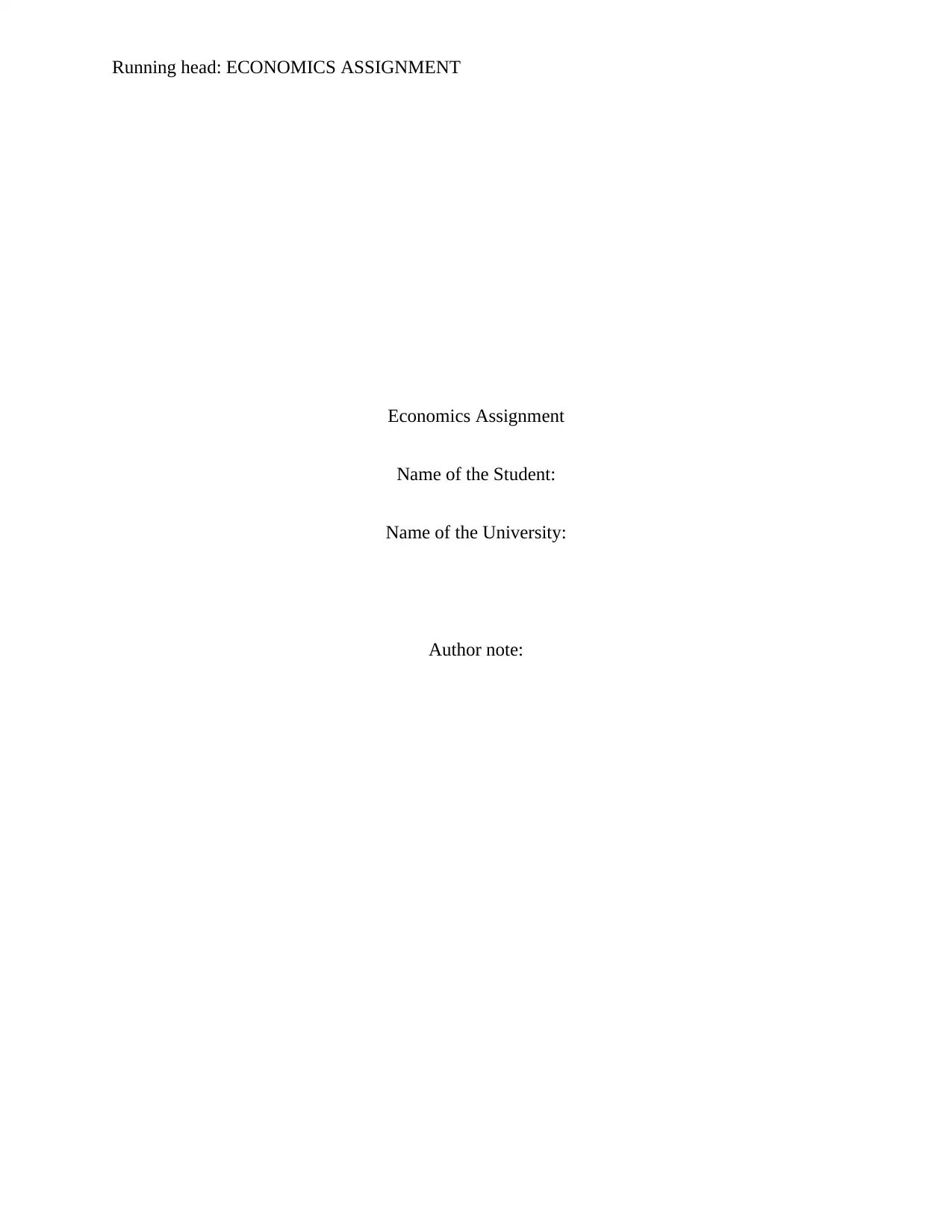
Running head: ECONOMICS ASSIGNMENT
Economics Assignment
Name of the Student:
Name of the University:
Author note:
Economics Assignment
Name of the Student:
Name of the University:
Author note:
Paraphrase This Document
Need a fresh take? Get an instant paraphrase of this document with our AI Paraphraser
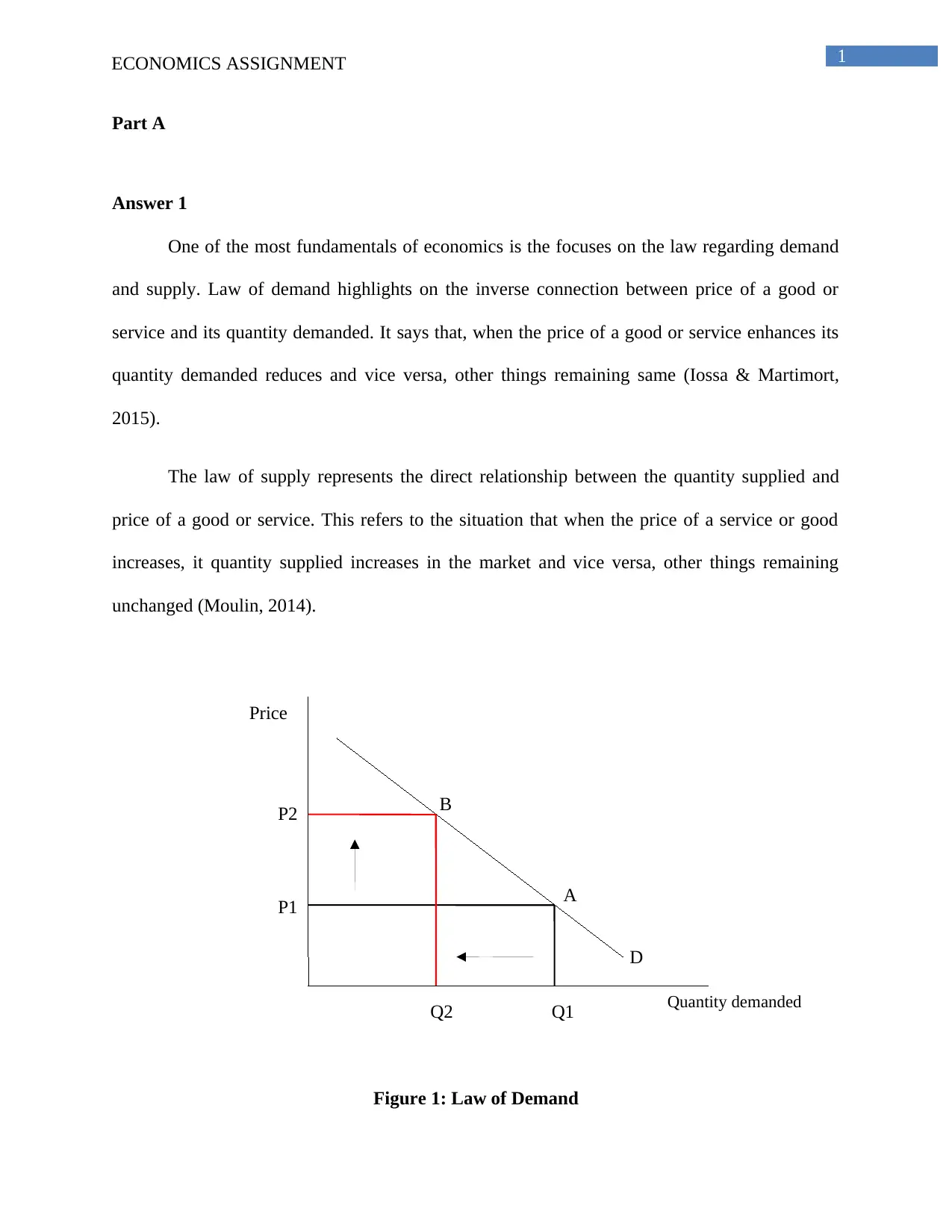
D
Price
Quantity demanded
Q2
P2
P1
Q1
B
A
1ECONOMICS ASSIGNMENT
Part A
Answer 1
One of the most fundamentals of economics is the focuses on the law regarding demand
and supply. Law of demand highlights on the inverse connection between price of a good or
service and its quantity demanded. It says that, when the price of a good or service enhances its
quantity demanded reduces and vice versa, other things remaining same (Iossa & Martimort,
2015).
The law of supply represents the direct relationship between the quantity supplied and
price of a good or service. This refers to the situation that when the price of a service or good
increases, it quantity supplied increases in the market and vice versa, other things remaining
unchanged (Moulin, 2014).
Figure 1: Law of Demand
Price
Quantity demanded
Q2
P2
P1
Q1
B
A
1ECONOMICS ASSIGNMENT
Part A
Answer 1
One of the most fundamentals of economics is the focuses on the law regarding demand
and supply. Law of demand highlights on the inverse connection between price of a good or
service and its quantity demanded. It says that, when the price of a good or service enhances its
quantity demanded reduces and vice versa, other things remaining same (Iossa & Martimort,
2015).
The law of supply represents the direct relationship between the quantity supplied and
price of a good or service. This refers to the situation that when the price of a service or good
increases, it quantity supplied increases in the market and vice versa, other things remaining
unchanged (Moulin, 2014).
Figure 1: Law of Demand
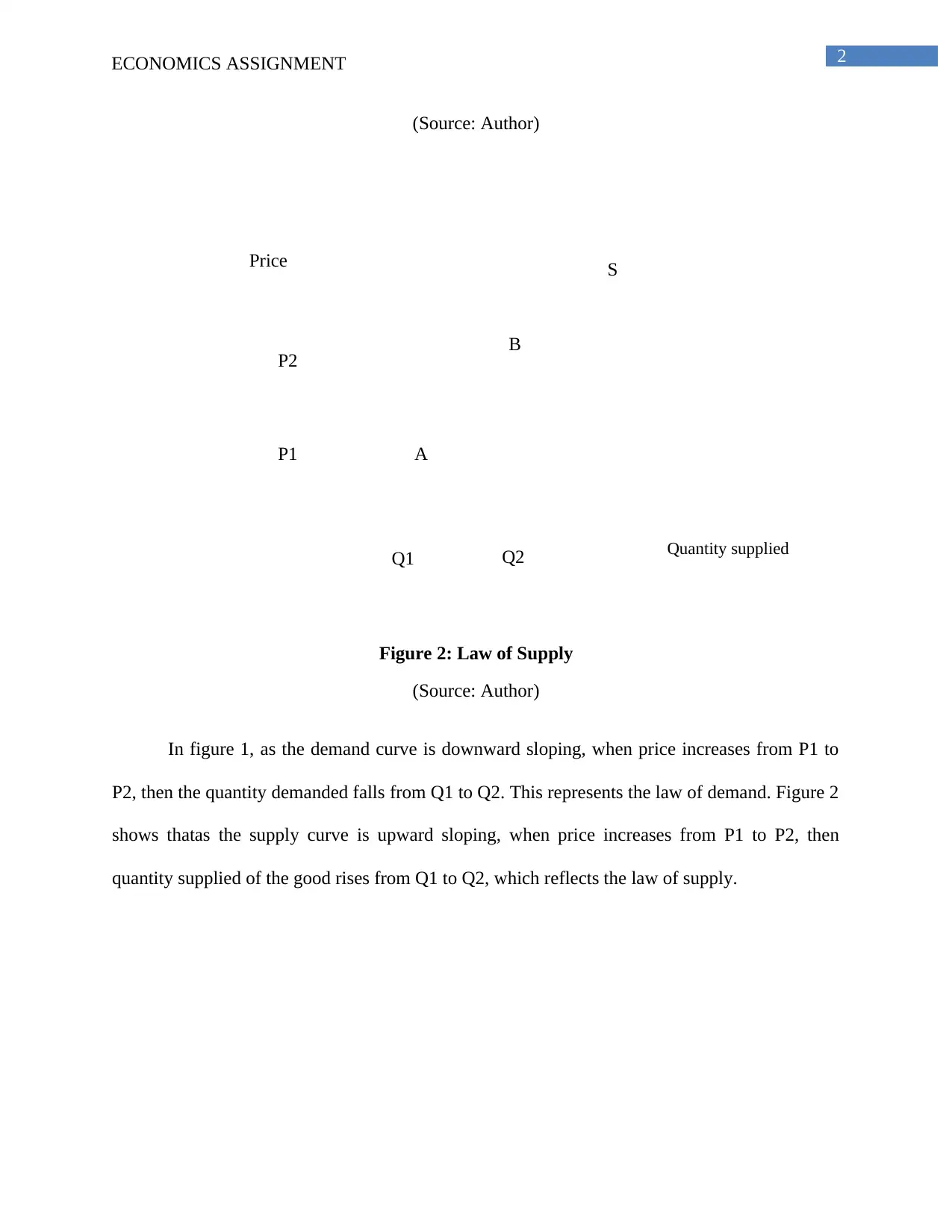
2ECONOMICS ASSIGNMENT
SPrice
Quantity supplied
Q1
P2
P1
Q2
A
B
(Source: Author)
Figure 2: Law of Supply
(Source: Author)
In figure 1, as the demand curve is downward sloping, when price increases from P1 to
P2, then the quantity demanded falls from Q1 to Q2. This represents the law of demand. Figure 2
shows thatas the supply curve is upward sloping, when price increases from P1 to P2, then
quantity supplied of the good rises from Q1 to Q2, which reflects the law of supply.
SPrice
Quantity supplied
Q1
P2
P1
Q2
A
B
(Source: Author)
Figure 2: Law of Supply
(Source: Author)
In figure 1, as the demand curve is downward sloping, when price increases from P1 to
P2, then the quantity demanded falls from Q1 to Q2. This represents the law of demand. Figure 2
shows thatas the supply curve is upward sloping, when price increases from P1 to P2, then
quantity supplied of the good rises from Q1 to Q2, which reflects the law of supply.
⊘ This is a preview!⊘
Do you want full access?
Subscribe today to unlock all pages.

Trusted by 1+ million students worldwide
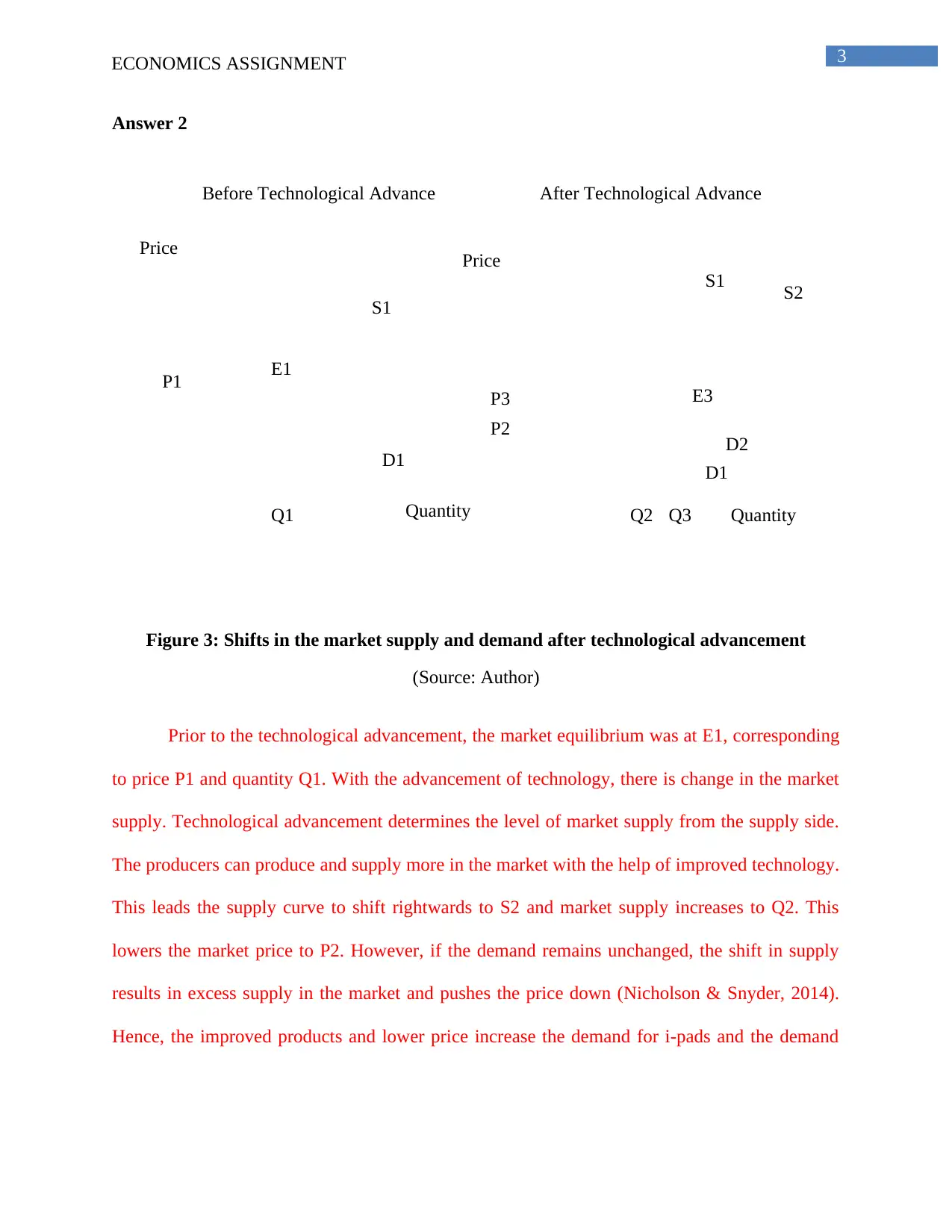
3ECONOMICS ASSIGNMENT
Before Technological Advance After Technological Advance
E3
P1 P3
S1
S1
D1 D1
D2
S2
Q3Q1 Q2
P2
E1
Price Price
QuantityQuantity
Answer 2
Figure 3: Shifts in the market supply and demand after technological advancement
(Source: Author)
Prior to the technological advancement, the market equilibrium was at E1, corresponding
to price P1 and quantity Q1. With the advancement of technology, there is change in the market
supply. Technological advancement determines the level of market supply from the supply side.
The producers can produce and supply more in the market with the help of improved technology.
This leads the supply curve to shift rightwards to S2 and market supply increases to Q2. This
lowers the market price to P2. However, if the demand remains unchanged, the shift in supply
results in excess supply in the market and pushes the price down (Nicholson & Snyder, 2014).
Hence, the improved products and lower price increase the demand for i-pads and the demand
Before Technological Advance After Technological Advance
E3
P1 P3
S1
S1
D1 D1
D2
S2
Q3Q1 Q2
P2
E1
Price Price
QuantityQuantity
Answer 2
Figure 3: Shifts in the market supply and demand after technological advancement
(Source: Author)
Prior to the technological advancement, the market equilibrium was at E1, corresponding
to price P1 and quantity Q1. With the advancement of technology, there is change in the market
supply. Technological advancement determines the level of market supply from the supply side.
The producers can produce and supply more in the market with the help of improved technology.
This leads the supply curve to shift rightwards to S2 and market supply increases to Q2. This
lowers the market price to P2. However, if the demand remains unchanged, the shift in supply
results in excess supply in the market and pushes the price down (Nicholson & Snyder, 2014).
Hence, the improved products and lower price increase the demand for i-pads and the demand
Paraphrase This Document
Need a fresh take? Get an instant paraphrase of this document with our AI Paraphraser
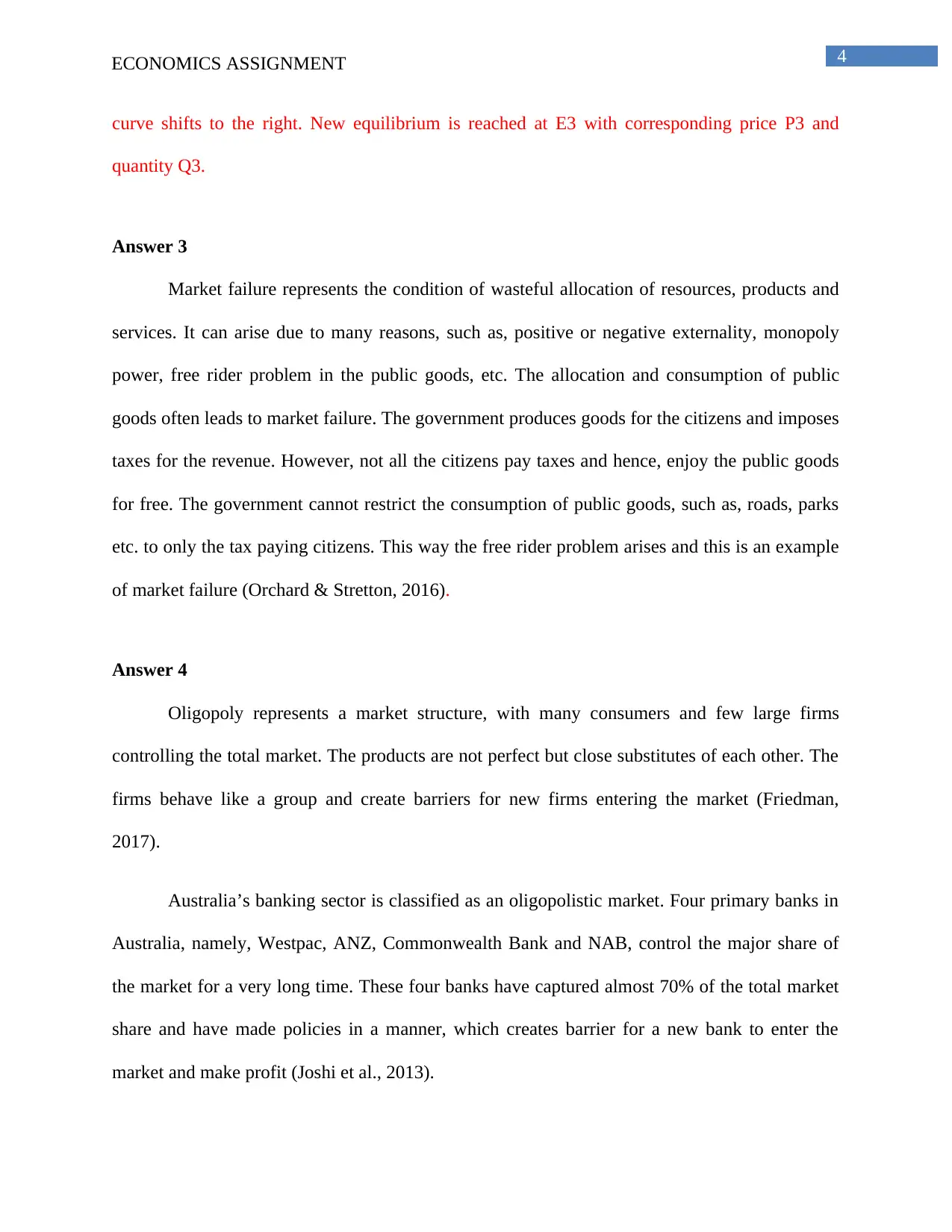
4ECONOMICS ASSIGNMENT
curve shifts to the right. New equilibrium is reached at E3 with corresponding price P3 and
quantity Q3.
Answer 3
Market failure represents the condition of wasteful allocation of resources, products and
services. It can arise due to many reasons, such as, positive or negative externality, monopoly
power, free rider problem in the public goods, etc. The allocation and consumption of public
goods often leads to market failure. The government produces goods for the citizens and imposes
taxes for the revenue. However, not all the citizens pay taxes and hence, enjoy the public goods
for free. The government cannot restrict the consumption of public goods, such as, roads, parks
etc. to only the tax paying citizens. This way the free rider problem arises and this is an example
of market failure (Orchard & Stretton, 2016).
Answer 4
Oligopoly represents a market structure, with many consumers and few large firms
controlling the total market. The products are not perfect but close substitutes of each other. The
firms behave like a group and create barriers for new firms entering the market (Friedman,
2017).
Australia’s banking sector is classified as an oligopolistic market. Four primary banks in
Australia, namely, Westpac, ANZ, Commonwealth Bank and NAB, control the major share of
the market for a very long time. These four banks have captured almost 70% of the total market
share and have made policies in a manner, which creates barrier for a new bank to enter the
market and make profit (Joshi et al., 2013).
curve shifts to the right. New equilibrium is reached at E3 with corresponding price P3 and
quantity Q3.
Answer 3
Market failure represents the condition of wasteful allocation of resources, products and
services. It can arise due to many reasons, such as, positive or negative externality, monopoly
power, free rider problem in the public goods, etc. The allocation and consumption of public
goods often leads to market failure. The government produces goods for the citizens and imposes
taxes for the revenue. However, not all the citizens pay taxes and hence, enjoy the public goods
for free. The government cannot restrict the consumption of public goods, such as, roads, parks
etc. to only the tax paying citizens. This way the free rider problem arises and this is an example
of market failure (Orchard & Stretton, 2016).
Answer 4
Oligopoly represents a market structure, with many consumers and few large firms
controlling the total market. The products are not perfect but close substitutes of each other. The
firms behave like a group and create barriers for new firms entering the market (Friedman,
2017).
Australia’s banking sector is classified as an oligopolistic market. Four primary banks in
Australia, namely, Westpac, ANZ, Commonwealth Bank and NAB, control the major share of
the market for a very long time. These four banks have captured almost 70% of the total market
share and have made policies in a manner, which creates barrier for a new bank to enter the
market and make profit (Joshi et al., 2013).
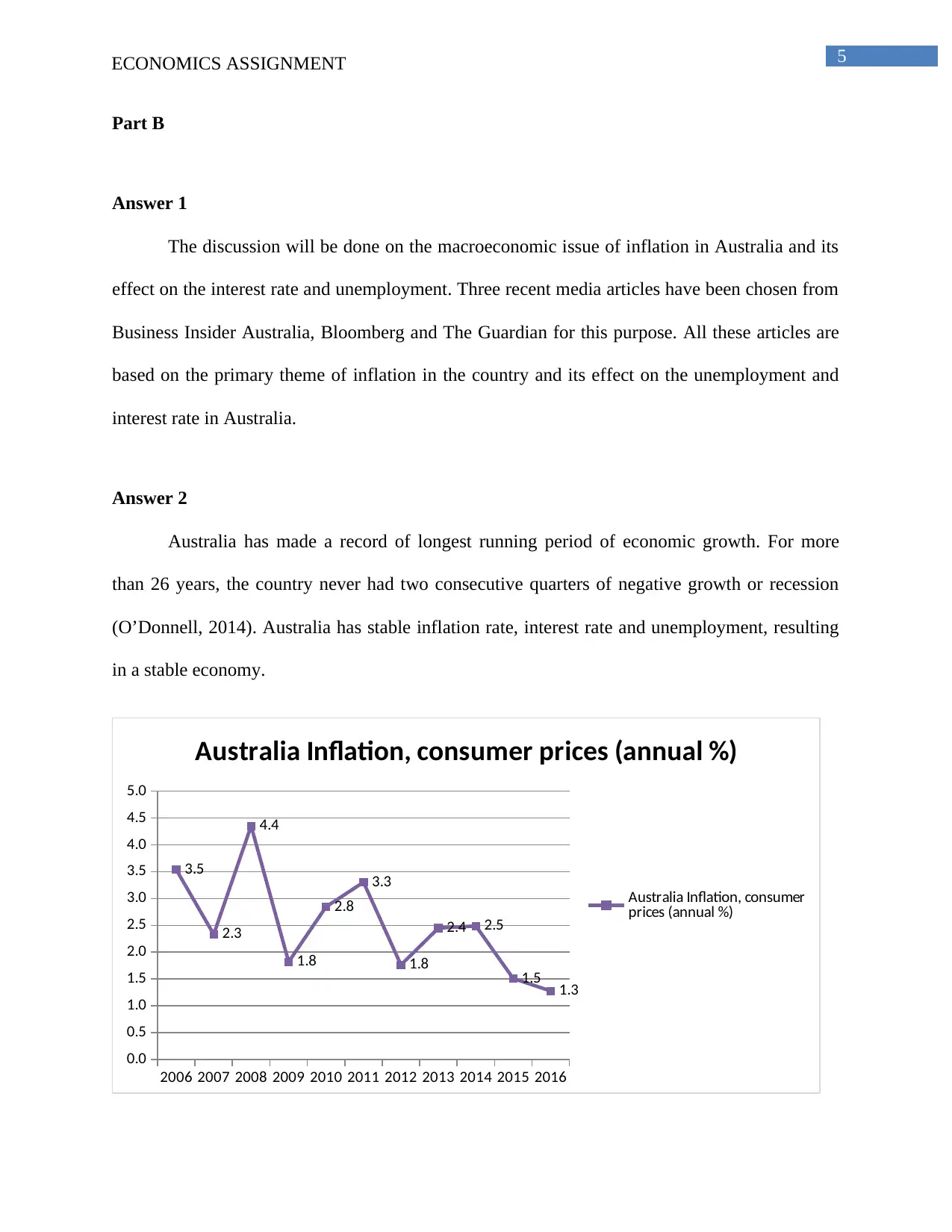
5ECONOMICS ASSIGNMENT
Part B
Answer 1
The discussion will be done on the macroeconomic issue of inflation in Australia and its
effect on the interest rate and unemployment. Three recent media articles have been chosen from
Business Insider Australia, Bloomberg and The Guardian for this purpose. All these articles are
based on the primary theme of inflation in the country and its effect on the unemployment and
interest rate in Australia.
Answer 2
Australia has made a record of longest running period of economic growth. For more
than 26 years, the country never had two consecutive quarters of negative growth or recession
(O’Donnell, 2014). Australia has stable inflation rate, interest rate and unemployment, resulting
in a stable economy.
2006 2007 2008 2009 2010 2011 2012 2013 2014 2015 2016
0.0
0.5
1.0
1.5
2.0
2.5
3.0
3.5
4.0
4.5
5.0
3.5
2.3
4.4
1.8
2.8
3.3
1.8
2.4 2.5
1.5 1.3
Australia Inflation, consumer prices (annual %)
Australia Inflation, consumer
prices (annual %)
Part B
Answer 1
The discussion will be done on the macroeconomic issue of inflation in Australia and its
effect on the interest rate and unemployment. Three recent media articles have been chosen from
Business Insider Australia, Bloomberg and The Guardian for this purpose. All these articles are
based on the primary theme of inflation in the country and its effect on the unemployment and
interest rate in Australia.
Answer 2
Australia has made a record of longest running period of economic growth. For more
than 26 years, the country never had two consecutive quarters of negative growth or recession
(O’Donnell, 2014). Australia has stable inflation rate, interest rate and unemployment, resulting
in a stable economy.
2006 2007 2008 2009 2010 2011 2012 2013 2014 2015 2016
0.0
0.5
1.0
1.5
2.0
2.5
3.0
3.5
4.0
4.5
5.0
3.5
2.3
4.4
1.8
2.8
3.3
1.8
2.4 2.5
1.5 1.3
Australia Inflation, consumer prices (annual %)
Australia Inflation, consumer
prices (annual %)
⊘ This is a preview!⊘
Do you want full access?
Subscribe today to unlock all pages.

Trusted by 1+ million students worldwide
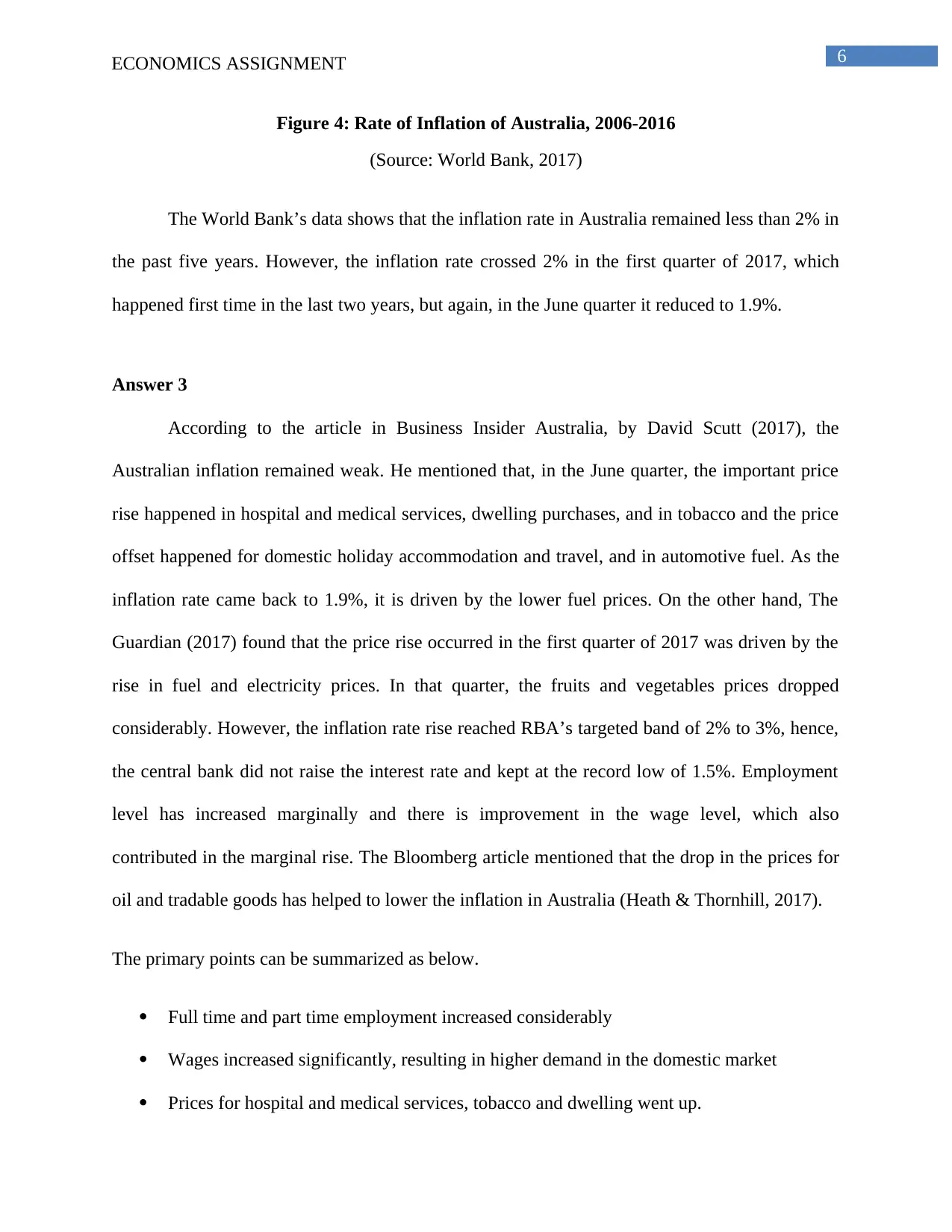
6ECONOMICS ASSIGNMENT
Figure 4: Rate of Inflation of Australia, 2006-2016
(Source: World Bank, 2017)
The World Bank’s data shows that the inflation rate in Australia remained less than 2% in
the past five years. However, the inflation rate crossed 2% in the first quarter of 2017, which
happened first time in the last two years, but again, in the June quarter it reduced to 1.9%.
Answer 3
According to the article in Business Insider Australia, by David Scutt (2017), the
Australian inflation remained weak. He mentioned that, in the June quarter, the important price
rise happened in hospital and medical services, dwelling purchases, and in tobacco and the price
offset happened for domestic holiday accommodation and travel, and in automotive fuel. As the
inflation rate came back to 1.9%, it is driven by the lower fuel prices. On the other hand, The
Guardian (2017) found that the price rise occurred in the first quarter of 2017 was driven by the
rise in fuel and electricity prices. In that quarter, the fruits and vegetables prices dropped
considerably. However, the inflation rate rise reached RBA’s targeted band of 2% to 3%, hence,
the central bank did not raise the interest rate and kept at the record low of 1.5%. Employment
level has increased marginally and there is improvement in the wage level, which also
contributed in the marginal rise. The Bloomberg article mentioned that the drop in the prices for
oil and tradable goods has helped to lower the inflation in Australia (Heath & Thornhill, 2017).
The primary points can be summarized as below.
Full time and part time employment increased considerably
Wages increased significantly, resulting in higher demand in the domestic market
Prices for hospital and medical services, tobacco and dwelling went up.
Figure 4: Rate of Inflation of Australia, 2006-2016
(Source: World Bank, 2017)
The World Bank’s data shows that the inflation rate in Australia remained less than 2% in
the past five years. However, the inflation rate crossed 2% in the first quarter of 2017, which
happened first time in the last two years, but again, in the June quarter it reduced to 1.9%.
Answer 3
According to the article in Business Insider Australia, by David Scutt (2017), the
Australian inflation remained weak. He mentioned that, in the June quarter, the important price
rise happened in hospital and medical services, dwelling purchases, and in tobacco and the price
offset happened for domestic holiday accommodation and travel, and in automotive fuel. As the
inflation rate came back to 1.9%, it is driven by the lower fuel prices. On the other hand, The
Guardian (2017) found that the price rise occurred in the first quarter of 2017 was driven by the
rise in fuel and electricity prices. In that quarter, the fruits and vegetables prices dropped
considerably. However, the inflation rate rise reached RBA’s targeted band of 2% to 3%, hence,
the central bank did not raise the interest rate and kept at the record low of 1.5%. Employment
level has increased marginally and there is improvement in the wage level, which also
contributed in the marginal rise. The Bloomberg article mentioned that the drop in the prices for
oil and tradable goods has helped to lower the inflation in Australia (Heath & Thornhill, 2017).
The primary points can be summarized as below.
Full time and part time employment increased considerably
Wages increased significantly, resulting in higher demand in the domestic market
Prices for hospital and medical services, tobacco and dwelling went up.
Paraphrase This Document
Need a fresh take? Get an instant paraphrase of this document with our AI Paraphraser
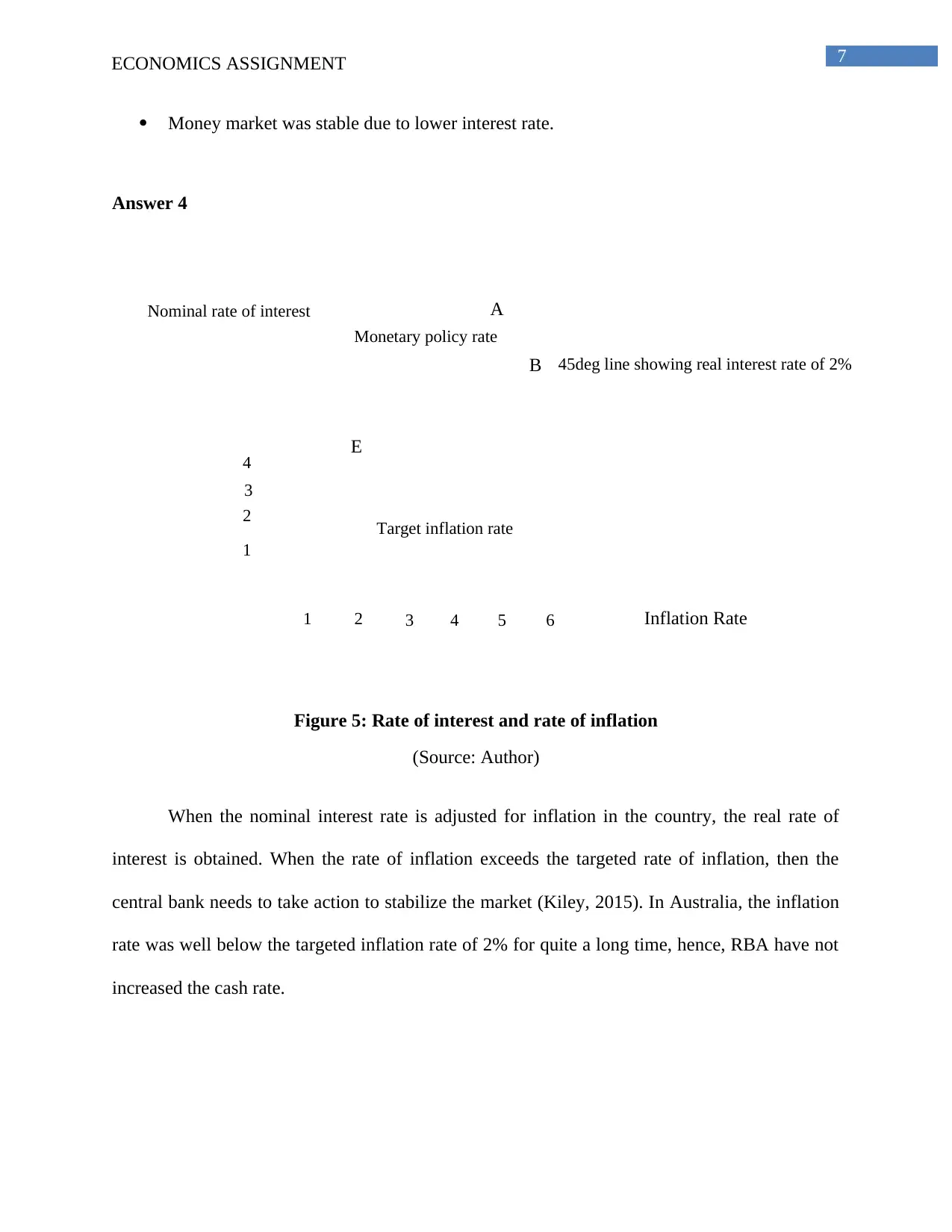
7ECONOMICS ASSIGNMENT
Nominal rate of interest
Inflation Rate
B
A
E
Target inflation rate
Monetary policy rate
4321
4
3
2
1
5 6
45deg line showing real interest rate of 2%
Money market was stable due to lower interest rate.
Answer 4
Figure 5: Rate of interest and rate of inflation
(Source: Author)
When the nominal interest rate is adjusted for inflation in the country, the real rate of
interest is obtained. When the rate of inflation exceeds the targeted rate of inflation, then the
central bank needs to take action to stabilize the market (Kiley, 2015). In Australia, the inflation
rate was well below the targeted inflation rate of 2% for quite a long time, hence, RBA have not
increased the cash rate.
Nominal rate of interest
Inflation Rate
B
A
E
Target inflation rate
Monetary policy rate
4321
4
3
2
1
5 6
45deg line showing real interest rate of 2%
Money market was stable due to lower interest rate.
Answer 4
Figure 5: Rate of interest and rate of inflation
(Source: Author)
When the nominal interest rate is adjusted for inflation in the country, the real rate of
interest is obtained. When the rate of inflation exceeds the targeted rate of inflation, then the
central bank needs to take action to stabilize the market (Kiley, 2015). In Australia, the inflation
rate was well below the targeted inflation rate of 2% for quite a long time, hence, RBA have not
increased the cash rate.
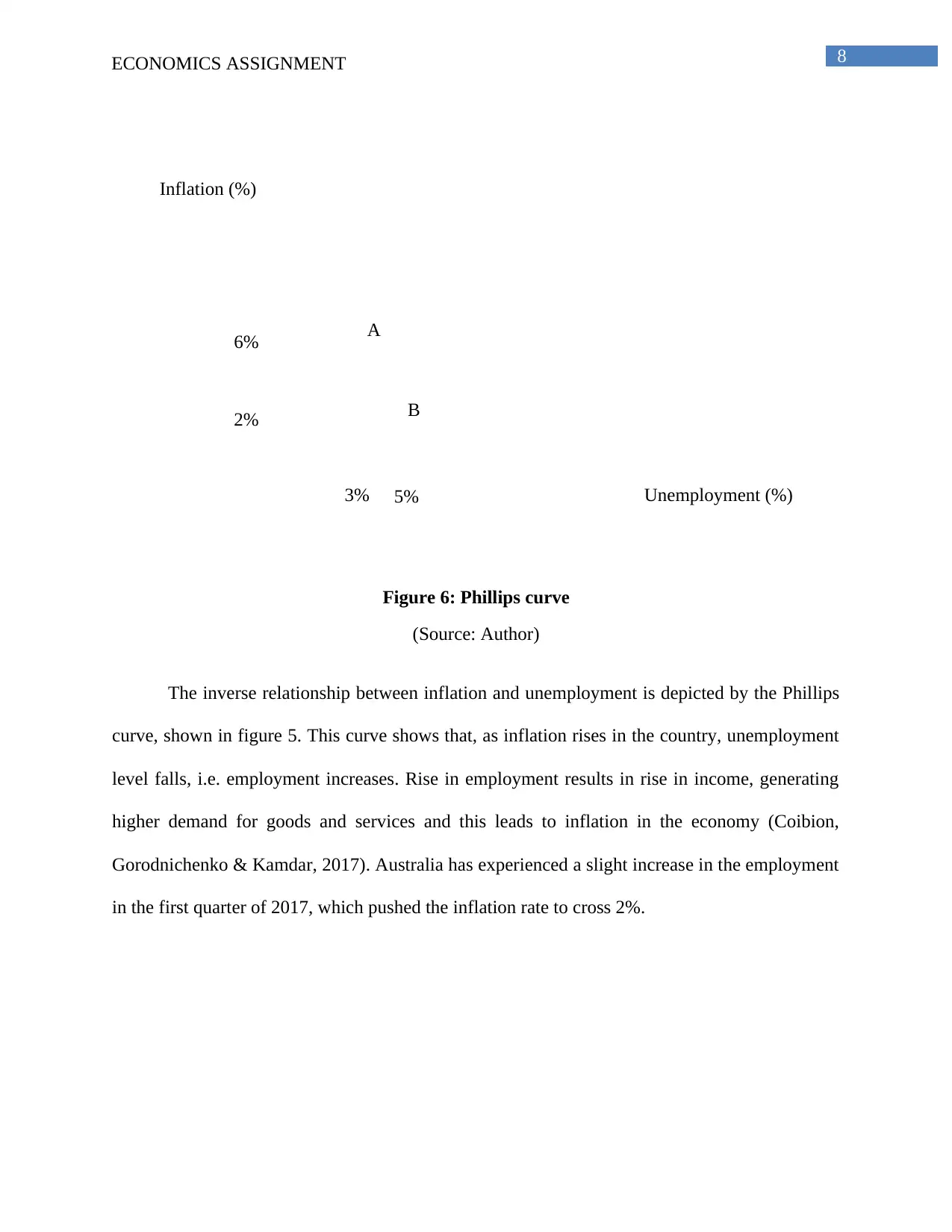
8ECONOMICS ASSIGNMENT
Inflation (%)
Unemployment (%)
6%
5%3%
2%
A
B
Figure 6: Phillips curve
(Source: Author)
The inverse relationship between inflation and unemployment is depicted by the Phillips
curve, shown in figure 5. This curve shows that, as inflation rises in the country, unemployment
level falls, i.e. employment increases. Rise in employment results in rise in income, generating
higher demand for goods and services and this leads to inflation in the economy (Coibion,
Gorodnichenko & Kamdar, 2017). Australia has experienced a slight increase in the employment
in the first quarter of 2017, which pushed the inflation rate to cross 2%.
Inflation (%)
Unemployment (%)
6%
5%3%
2%
A
B
Figure 6: Phillips curve
(Source: Author)
The inverse relationship between inflation and unemployment is depicted by the Phillips
curve, shown in figure 5. This curve shows that, as inflation rises in the country, unemployment
level falls, i.e. employment increases. Rise in employment results in rise in income, generating
higher demand for goods and services and this leads to inflation in the economy (Coibion,
Gorodnichenko & Kamdar, 2017). Australia has experienced a slight increase in the employment
in the first quarter of 2017, which pushed the inflation rate to cross 2%.
⊘ This is a preview!⊘
Do you want full access?
Subscribe today to unlock all pages.

Trusted by 1+ million students worldwide
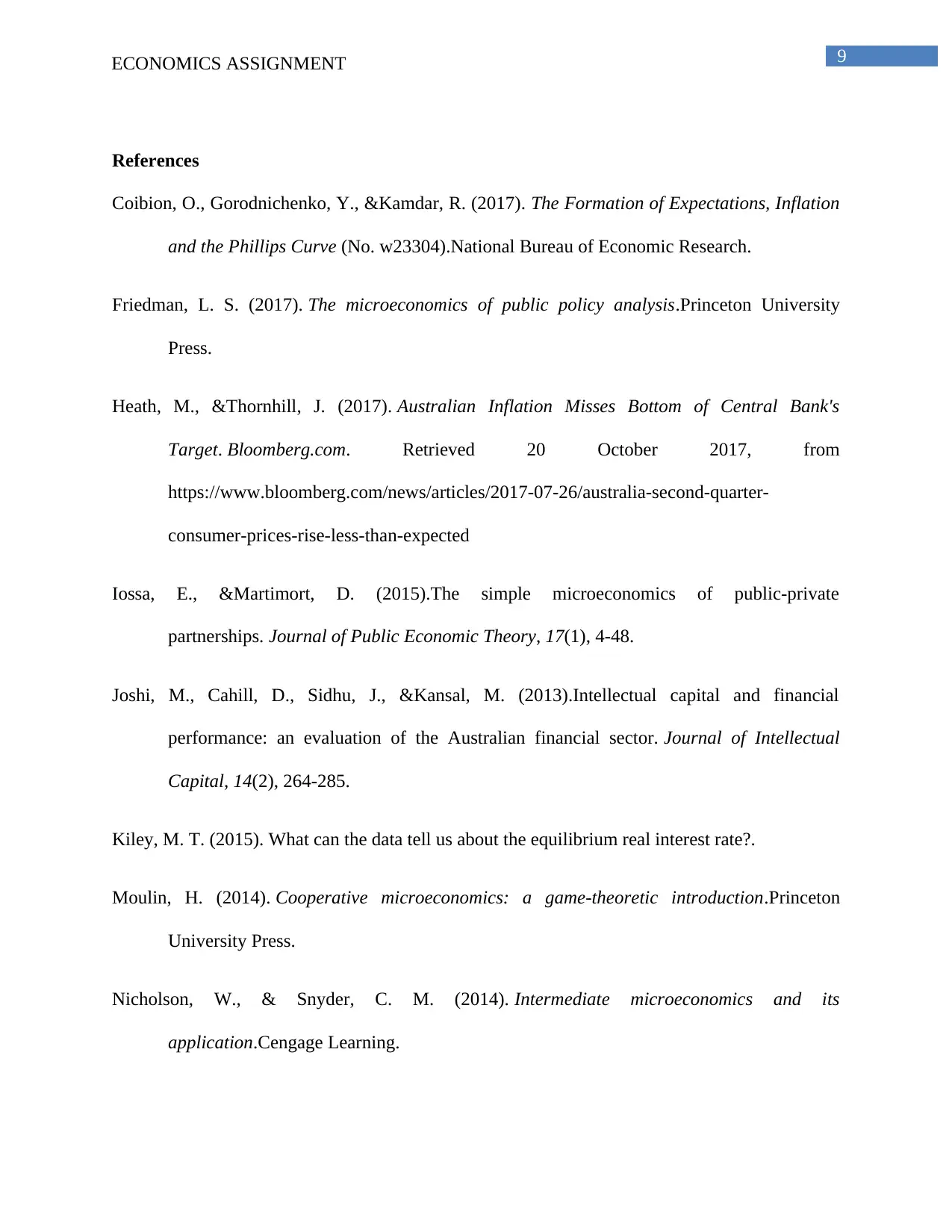
9ECONOMICS ASSIGNMENT
References
Coibion, O., Gorodnichenko, Y., &Kamdar, R. (2017). The Formation of Expectations, Inflation
and the Phillips Curve (No. w23304).National Bureau of Economic Research.
Friedman, L. S. (2017). The microeconomics of public policy analysis.Princeton University
Press.
Heath, M., &Thornhill, J. (2017). Australian Inflation Misses Bottom of Central Bank's
Target. Bloomberg.com. Retrieved 20 October 2017, from
https://www.bloomberg.com/news/articles/2017-07-26/australia-second-quarter-
consumer-prices-rise-less-than-expected
Iossa, E., &Martimort, D. (2015).The simple microeconomics of public‐private
partnerships. Journal of Public Economic Theory, 17(1), 4-48.
Joshi, M., Cahill, D., Sidhu, J., &Kansal, M. (2013).Intellectual capital and financial
performance: an evaluation of the Australian financial sector. Journal of Intellectual
Capital, 14(2), 264-285.
Kiley, M. T. (2015). What can the data tell us about the equilibrium real interest rate?.
Moulin, H. (2014). Cooperative microeconomics: a game-theoretic introduction.Princeton
University Press.
Nicholson, W., & Snyder, C. M. (2014). Intermediate microeconomics and its
application.Cengage Learning.
References
Coibion, O., Gorodnichenko, Y., &Kamdar, R. (2017). The Formation of Expectations, Inflation
and the Phillips Curve (No. w23304).National Bureau of Economic Research.
Friedman, L. S. (2017). The microeconomics of public policy analysis.Princeton University
Press.
Heath, M., &Thornhill, J. (2017). Australian Inflation Misses Bottom of Central Bank's
Target. Bloomberg.com. Retrieved 20 October 2017, from
https://www.bloomberg.com/news/articles/2017-07-26/australia-second-quarter-
consumer-prices-rise-less-than-expected
Iossa, E., &Martimort, D. (2015).The simple microeconomics of public‐private
partnerships. Journal of Public Economic Theory, 17(1), 4-48.
Joshi, M., Cahill, D., Sidhu, J., &Kansal, M. (2013).Intellectual capital and financial
performance: an evaluation of the Australian financial sector. Journal of Intellectual
Capital, 14(2), 264-285.
Kiley, M. T. (2015). What can the data tell us about the equilibrium real interest rate?.
Moulin, H. (2014). Cooperative microeconomics: a game-theoretic introduction.Princeton
University Press.
Nicholson, W., & Snyder, C. M. (2014). Intermediate microeconomics and its
application.Cengage Learning.
Paraphrase This Document
Need a fresh take? Get an instant paraphrase of this document with our AI Paraphraser
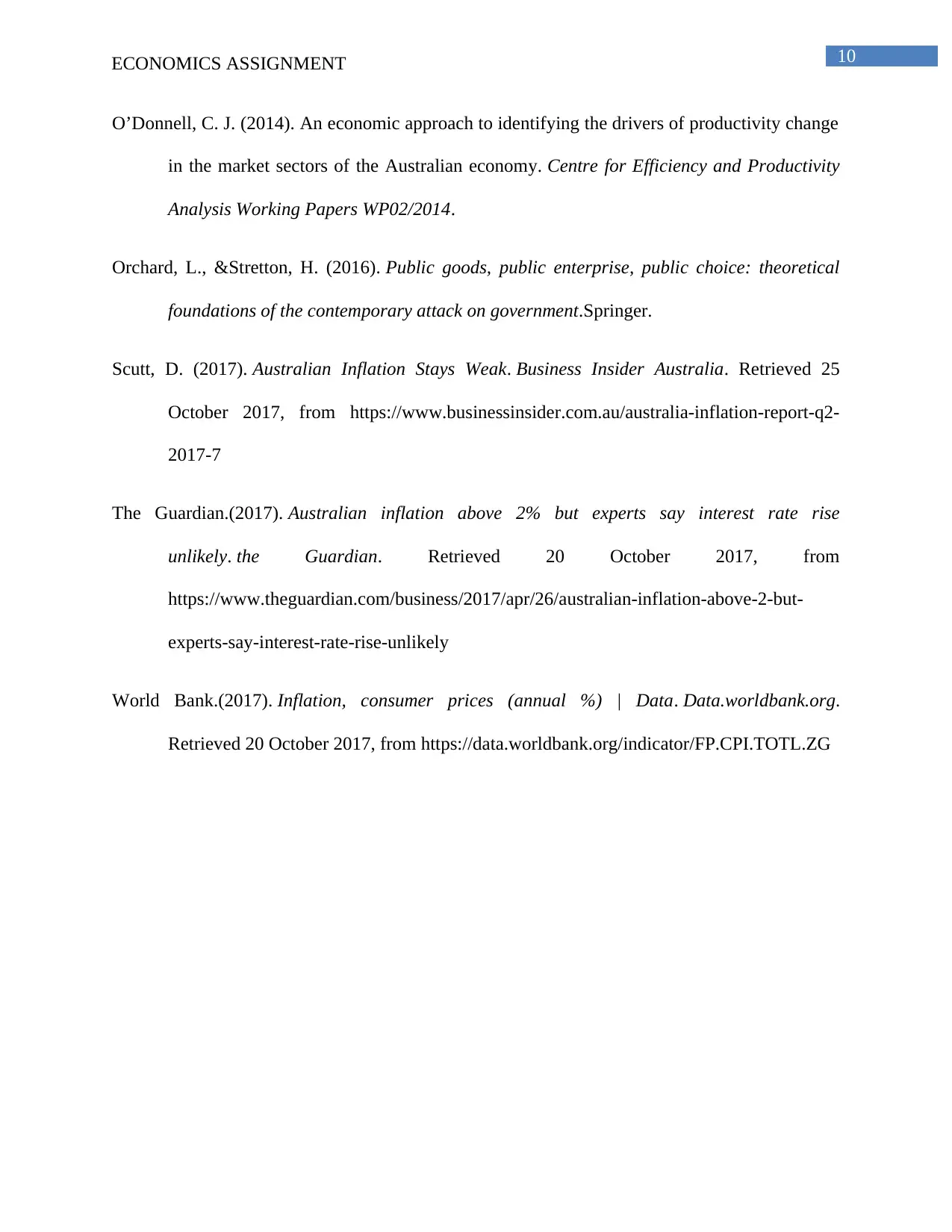
10ECONOMICS ASSIGNMENT
O’Donnell, C. J. (2014). An economic approach to identifying the drivers of productivity change
in the market sectors of the Australian economy. Centre for Efficiency and Productivity
Analysis Working Papers WP02/2014.
Orchard, L., &Stretton, H. (2016). Public goods, public enterprise, public choice: theoretical
foundations of the contemporary attack on government.Springer.
Scutt, D. (2017). Australian Inflation Stays Weak. Business Insider Australia. Retrieved 25
October 2017, from https://www.businessinsider.com.au/australia-inflation-report-q2-
2017-7
The Guardian.(2017). Australian inflation above 2% but experts say interest rate rise
unlikely. the Guardian. Retrieved 20 October 2017, from
https://www.theguardian.com/business/2017/apr/26/australian-inflation-above-2-but-
experts-say-interest-rate-rise-unlikely
World Bank.(2017). Inflation, consumer prices (annual %) | Data. Data.worldbank.org.
Retrieved 20 October 2017, from https://data.worldbank.org/indicator/FP.CPI.TOTL.ZG
O’Donnell, C. J. (2014). An economic approach to identifying the drivers of productivity change
in the market sectors of the Australian economy. Centre for Efficiency and Productivity
Analysis Working Papers WP02/2014.
Orchard, L., &Stretton, H. (2016). Public goods, public enterprise, public choice: theoretical
foundations of the contemporary attack on government.Springer.
Scutt, D. (2017). Australian Inflation Stays Weak. Business Insider Australia. Retrieved 25
October 2017, from https://www.businessinsider.com.au/australia-inflation-report-q2-
2017-7
The Guardian.(2017). Australian inflation above 2% but experts say interest rate rise
unlikely. the Guardian. Retrieved 20 October 2017, from
https://www.theguardian.com/business/2017/apr/26/australian-inflation-above-2-but-
experts-say-interest-rate-rise-unlikely
World Bank.(2017). Inflation, consumer prices (annual %) | Data. Data.worldbank.org.
Retrieved 20 October 2017, from https://data.worldbank.org/indicator/FP.CPI.TOTL.ZG
1 out of 11
Related Documents
Your All-in-One AI-Powered Toolkit for Academic Success.
+13062052269
info@desklib.com
Available 24*7 on WhatsApp / Email
![[object Object]](/_next/static/media/star-bottom.7253800d.svg)
Unlock your academic potential
Copyright © 2020–2025 A2Z Services. All Rights Reserved. Developed and managed by ZUCOL.




